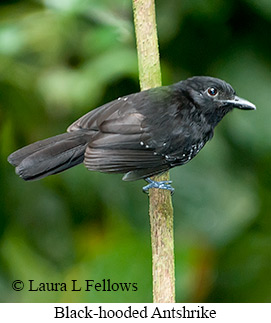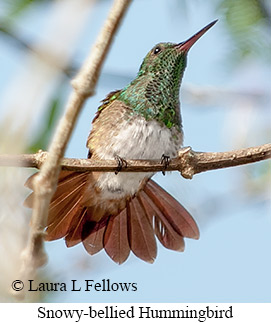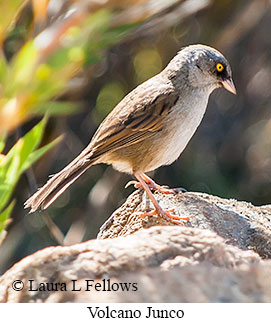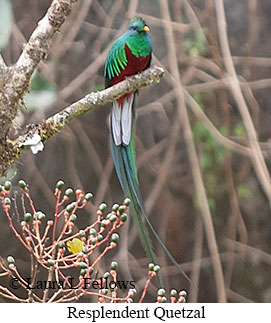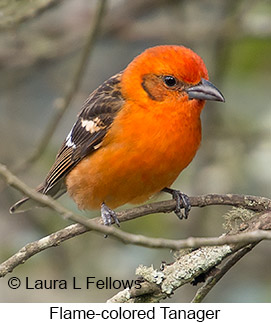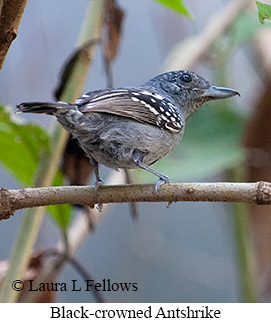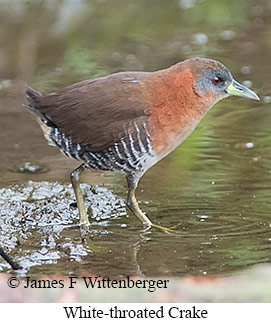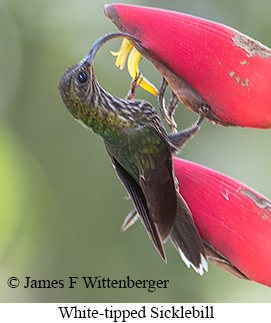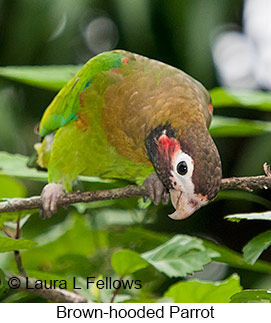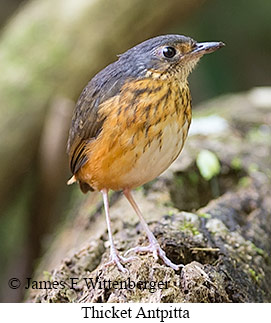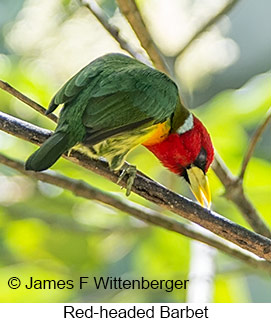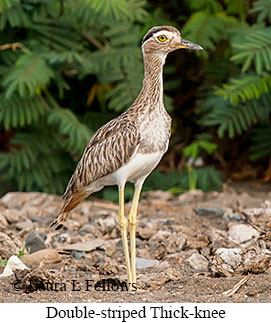COSTA RICA MEGA BIRDING TOUR
Tour Description

COSTA RICA
BIRDING TOUR
ANY TIME*
| Duration: | 21 days, 20 nights |
| Group Size: | 2-8 |
| Anytime Price: | $7850 |
| Group Price: | $7300 |
| Single Suppl: | $650 |
| Est #Species: | 400-450 |
| Pace: | Moderate |
| Difficulty: | Moderate |
| * This tour is available for any dates of your choosing provided guide services and accommodations are available. | |
DAY 1 - ALAJUELA
International flights arrive in the afternoon or evening. After arrival, transfer to nearby Hotel Aeropuerto, a 5-minute taxi ride from the international airport. Night in Alajuela.
DAY 2 - OROTINA, CEIBA-CASCAJAL ROAD, & CERRO LODGE
Depart early for the Pacific lowlands. The first stop is the central plaza of Orotina where Black-and-white Owls often roost during the day. Then continue to the nearby Ceibo-Cascajal Road, which offers excellent roadside birding through dry forest. The more forested areas are home to Black-headed Trogon, Turquoise-browed Motmot, Long-tailed Manakin, Tropical Royal-Flycatcher, Stub-tailed Spadebill, Nutting's Flycatcher, and Stripe-headed Sparrow. Scrubby areas offer Crested Bobwhite, Striped Cuckoo, the secretive Lesser Ground-Cuckoo, and wintering Grasshopper Sparrow and Painted Bunting. The open fields are home to Double-striped Thick-knee, Southern Lapwing, and Red-breasted Meadowlark. Arrive in time for lunch at Cerro Lodge. Afternoon birding near the lodge and from the veranda overlooking the gardens. The lodge has recently added an observation tower atop a hill, allowing good views at canopy birds. It's a good place for sightings of the uncommon Crane Hawk as well as other raptors such as Hook-billed Kite, Gray-headed Kite, Gray Hawk, Gray-lined Hawk, Short-tailed Hawk, and Bat Falcon. Late in the afternoon Scarlet Macaws usually appear at feeders behind the dining room. Other species sometimes seen on the grounds include Common Ground Dove, Blue-vented Hummingbird, Cinnamon Hummingbird, Black-headed Trogon, Gartered Trogon, White-necked Puffbird, Lineated Woodpecker, Hoffnann's Woodpecker, Orange-chinned Parakeet, Yellow-naped Parrot, Crimson-fronted Parakeet, Rufous-naped Wren, and Streak-backed Oriole. Night at Cerro Lodge.
DAY 3 - CARARA NATIONAL PARK
All day bird Carara National Park. The park is in a transitional zone between northern and southern Pacific coastal areas and attracts a nice combination of northern and southern species. Bird the Laguna Meandrica trail through secondary forest paralleling the Tarcoles River. This trail is wide and fairly level, affording easy walking. Specialties typically seen along the trail include White-whiskered Puffbird, Baird's Trogon, Black-hooded Antshrike, Slaty Antwren, Chestnut-backed Antwren, Orange-collared Manakin, Rufous-naped Wren, Black-bellied Wren, Rufous-and-white Wren, Scarlet-rumped Tanager, and Spot-crowned Euphonia. With luck one could also find Long-tailed Manakin and Rufous-breasted Wren. At the end of the trail are some ponds where roosting Boat-billed Herons are normally present in thick understory near the river. Also present sometimes are Black-bellied Whistling-Ducks. After lunch at the lodge, bird the Headquarters Trail at Carara. This trail goes through primary forest where species composition is quite different. The trail is flat, paved, and easy. Notable species possible include Gray-chested Dove, Bronzy Hermit, White-whiskered Puffbird, Black-hooded Antshrike, Streak-chested Antpitta, Tawny-winged Woodcreeper, Northern Bentbill, Stub-tailed Spadebill, Riverside Wren, Long-billed Gnatwren, Orange-billed Sparrow, and Yellow-throated Euphonia. Night at Cerro Lodge.
DAY 4 - TRANSFER & OSA PENINSULA
Depart early for Osa Peninsula. Enroute stop near Quepos to look for the scarce Spot-fronted Swift as well as the more common Costa Rican Swift. Another stop at the bridge over the Rincon River is a reliable site for the scarce and declining Yellow-billed Cotinga. Continue on to our lodge for the next 3 nights, Danta Corcovado Lodge, located 5km from the town of La Palma and very near Corcovado National Park. This lodge is located near the Yellow-billed Cotinga Reserve, so if we missed the cotinga by the bridge we should see it near the lodge. After arrival birding on the lodge grounds. Night at Danta Corcovado Lodge.
DAYS 5-6 - OSA PENINSULA
We'll have two full days birding the extensive trails around the lodge. The habitat on the lodge grounds is a mix of primary and secondary forest on the 30-hectare property. Key target species include Rufous-winged Woodpecker, Black-hooded Antshrike, Chiriqui Foliage-gleaner, Yellow-billed Cotinga, and Black-cheeked Ant-Tanager. Other interesting species present include Littel Tinamou, Marbled Wood-Quail, Bare-throated Tiger-Heron, various raptors, Red-crowned Woodpecker, Red-rumped Woodpecker, Rufous-winged Woodpecker, Dot-winged Antwren, Dusky Antbird, Chestnut-backed Antbird, Ruddy Woodcreeper, Velvety Manakin, Orange-collared Manakin, Red-capped Manakin, numerous flycatchers, and numerous tanagers. Hummingbirds present on the grounds include Band-tailed Barbthroa, Stripe-throated Hermit, Purple-crowned Fairy, White-crested Coquette, Long-billed Starthroat, Garden Emerald, Violet-headed Hummingbird, Mangrove Hummingbird, and Blue-throated Goldentail. Nights at Danta Corcovado Lodge.
DAY 7 - TRANSFER & WILSON BOTANICAL GARDNS
Morning birding near lodge. After breakfast transfer to Wilson Botanical Gardens near San Vito for a one night stay. Rest of the day birding the gardens. The grounds are easy walking and offer excellent birding opportunities. In addition to Turquoise Cotinga, a species that appears erratically but regularly, we expect to see a good variety of garden and open woodland species. Likely birds include Gray-necked Wood-Rail, Red-crowned Woodpecker, Brown-throated Parakeet, Red-headed Barbet, Fiery-billed Aracari, Scarlet-rumped Tanager, Orange-billed Sparrow, and 5 species of euphonias including Yellow-crowned Euphonia, Elegant Euphonia, Spot-crowned Euphonia, and White-vented Euphonia. Hummingbird feeders near the dining room may attract Magenta-throated Woodstar, Scaly-breasted Hummingbird, White-tailed Emerald, Violet Sabrewing, Charming Hummingbird, and Snowy-bellied Hummingbird. Night at Wilson Botanical Gardens.
DAY 8 - WILSON BOTANICAL GARDENS & TALAMANCA HIGHLANDS
Morning birding in the gardens to look for any species missed the previous day. After breakfast depart for the highlands, stopping at San Joaquin Wetlands outside San Vito to look for Chiriqui Yellowthroat, a likely future split from Olive-crowned Yellowthroat. Continue north to San Isidro de El General for a lunch stop, about a 2-hour drive. After lunch, drive the steep road into the Talamanca highlands, stopping at Georgina's Restaurant in the highlands for a snack and viewing high altitude hummingbirds. It's the best place to see Fiery-throated Hummingbird, a species not normally present in San Gerardo de Dota. Also possible are Volcano Hummingbird and Violet Sabrewing. Seed feeders there often draw in other specialties such as Ruddy-capped Nightingale-Thrush, Sooty Finch, Elegant Euphonia, and Large-footed Finch. Then drive up the winding road to the top of Cerro de la Muerte, so-named because for a long time people had to travel through these mountains on horseback or on foot to reach San Jose before the road was constructed in the 1950's, and ill-prepared travelers sometimes perished enroute. Birding the road up to the antenna area atop Cerro de la Muerte should produce several high elevation specialties, notably Volcano Hummingbird, Timberline Wren, Peg-billed Finch, Sooty-capped Chlorospingus, Volcano Junco, and Large-footed Finch. We'll stop at a local but quite pleasant restaurant at the road juction that descends into the valley for lunch before continuing down into the vallyey of San Gerardo de Dota and our lodge. After arrival, we'll visit the hummingbird feeders at the lodge, which attract species such as Lesser Violetear, Green-crowned Brilliant, Talamanca Hummingbird, Purple-throated Mountain-gem, White-throated Mountain-gem, Scintillant Hummingbird, Crowned Woodnymph, and Rufous-tailed Hummingbird. Night at Savegre Mountain Lodge.
DAY 9 - PARAISO QUETZALES & SAN GERARDO DE DOTA
Depart early for an excursion to Paraiso Quetzales, where they have a program for getting good views of Resplendent Quetzals on a local finca. Then view hummingbirds coming to feeders near Paraiso Quetzales Lodge. Return to our lodge for lunch. Afternoon drive high up the mountain behind the lodge and bird the trail going back down. It's possible to see Resplendent Quetzal once again, though not reliably so. More importantly, we'll seek other highland species of note such as Spotted Wood-Quail, Ruddy Pigeon, Barred Parakeet, Sulphur-winged Parakeet, Lineated Foliage-gleaner, Streak-breasted Treehunter, Ruddy Treerunner, Mountain Elaenia, Yellow-winged Vireo, Black-faced Solitaire, Black-billed Nightingale-Thrush, Long-tailed Silky-Flycatcher, Black-cheeked Warbler, Wrenthrush, Spangle-cheeked Tanager, Silver-throated Tanager, Peg-billed Finch, and Flame-colored Tanager. Night at Savegre Mountain Hotel.
DAY 10 - RESERVA EL COPAL & QUELITALES
Depart early for Reserva el Copal, located in the highlands southeast of Cartagena, about a 3-hour drive. We'll spend much of the day birding this foothill site on the Caribbean slope of Costa Rica. It's especially good for tanagers, including Flame-colored Tanager, White-winged Tanager, Red-throated Ant-Tanager, Tawny-crested Tanager, Crimson-collared Tanager, Scarlet-rumped Tanager, Speckled Tanager, Golden-hooded Tanager, Spangle-cheeked Tanager, Rufous-winged Tanager, Bay-headed Tanager, Emerald Tanager, and Silver-throated Tanager. Many other forest birds are also present at this site. In late afternoon we'll continue on to our hotel near the town of Quelitales. The hotel grounds have hummingbird feeders and gardens that attract about 70% of all hummingbird species found in Costa Rica (more than 30 species). Night at Hotel Quelitales.
DAY 11 - HOTEL QUELITALES & SARAPIQUI
We'll spend the morning birding the grounds around hotel Quelitales. Key species of interest in addition to humminbirds are Red-headed Barbet, Ochre-breasted Antpitta, Dark Pewee, Slaty-backed Nightingale-Thrush, Sooty-faced Finch, and Cabanis's Ground-Sparrow. This is one of the best places to see the extremely elusive Scaled Antpitta. Afternoon transfer to the Sarapiqui area near Puerto Viejo. Enroute stop near El Tapir Nature Reserve to look for Snowcap and other hummingbirds in the flowering beds and then stop to bird some additional sites along the way before arriving in Puerto Viejo. The main target species at these sites are Canebrake Wren, a split from Plain Wren, and Gray-crowned Yellowthroat. Raptors such as White Hawk, Gray-lined Hawk, and Bat Falcon are also possible. Night at Hotel Ara Ambigua.
DAY 12 - LA SELVA BIOLOGICAL STATION
We'll depart very early for nearby La Selva Biological Station, probably birding the entrance road before entering the reserve. Over 400 species have been recorded in this reserve. Access to some trails is restricted for most groups, but we can usually get exceptional access because our guide is Costa Rican and works at La Selva when not guiding groups. In addition to the entrance road, birding is around the clearing near the visitor center and and along an extensive network of trails through primary and secondary forest. It's preferable to bird the forest interior early when bird activity is at its best. Several hundred species are possible and we see different ones on every visit, which is typical when birding in rainforest. Possibilities include Great Tinamou, Semiplumbeous Hawk, Chestnut-colored Woodpecker, Pale-billed Woodpecker, Fasciated Antshrike, Great Antshrike, Black-crowned Antshrike, Black-headed Tody-Flycatcher, Bare-necked Umbrellabird, White-collared Manakin, Crimson-collared Tanager, Golden-hooded Tanager, Dusky-faced Tanager, and many more. If an army ant swarm is encountered, obligate and opportunistic army ant followers such as Bicolored Antbird, Ocellated Antbird, Gray-headed Tanager and Red-throated Ant-Tanager are very possible. At mid-day when birding has slowed substantially, we may drive the short distance to Selva Verde Lodge for lunch if Sunbitterns have been seen recently along the river there. Afternoon, we'll return to La Selva or bird some other areas near Puerto Viejo. Night at Hotel Ara Ambigua.
DAY 13 - LOS CHILES & CAÑO NEGRO WILDLIFE REFUGE
Depart after breakfast for Los Chiles in the far north near the border with Nicaragua. Afternoon we'll take a boat out onto the lagoon, where many water birds abound. Notable birds we expect to see include Black-bellied Whistling-Duck, Yellow-breasted Crake, White-throated Crake, Northern Jacana, Pinnated Bittern, and Least Bittern. We should have some time to bird outside town as well. Birds we may find include Striped Owl, Sulphur-winged Parakeet, Olive-throated Parakeet, Nicaraguan Grackle, and Nicaraguan Seed-Finch. Night at a hotel in Los Chiles.
DAY 14 - LOS CHILES & CELESTE MOUNTAIN LODGE
After some early morning birding, transfer to Celeste Mountain Lodge near Bijagua. This out-of-the-way lodge is situated in a superb birding area near Tenorio National Park. It offers fine accommodations in addition to excellent birding on forest trails through its property. Heliconias near the entrance road attracts White-tipped Sicklebill and Stripe-throated Hermit hummingbirds. We'll spend the afternoon birding these trails. Birds we hope to see include Tody Motmot, Black-cheeked Woodpecker, Brown-headed Parrot, Dull-mantled Antbird, White-ruffed Manakin, Rufous Piha, B;acl-striped Sparrow, and various tanagers. Night at Celeste Mountain Lodge.
DAY 15 - BIJAGUA AREA
We'll devote the morning to birding forest trails at nearby Heliconias Lodge. This private reserve is an excellent place for antbirds. Our primary target is Ocellated Antbird, which is an obligate follower of army ant swarms. Other birds we may see include Crested Guan, Tody Motmot,Black-crowned Antshrike, Streak-throated Antvireo, White-flanked Antwren, Slaty Antwren, Spotted Antbird, Long-tailed Manakin, Bright-rumped Attila, and Nightingale Wren.
Afternoon we'll devote to birding nearby Tapir Valley Nature Reserve. There are three observation platforms in the reserve, one for viewing wetlands, one for viewing the forest canopy, and one for viewing hummingbirds. Nearly 30 species of hummingbirds have been recorded in the reserve. Birds of special interest on forest trails include Great Curassow, Ornate Hawk-Eagle, Lattice-tailed Trogon, Tody Motmot, Keel-billed Motmot, Yellow-eared Toucanet, Brown-hooded Parrot, Dull-mantled Antbird, White-collared Manakin, Bare-necked Umbrellabird, Lovely Cotinga, Yellow-winged Tanager, and Rufous-winged Tanager. Night at Celeste Mountain Lodge.
DAY 16 - TRANSFER & ARENAL OBSERVATORY LODGE
After some morning birding around the lodge, we'll depart for Arenal. Enroute we'll do some roadside birding looking especially for Lovely Cotinga if missed the previous day. After arrival, we'll have some time to bird around the lodge grounds. Night at Arenal Observatory Lodge.
DAY 17 - ARENAL AREA
All day birding trails around the lodge. One trail is a very good spot to find the secretive Wrenthrush. Other possibilities of special interest include Keel-billed Motmot, Smoky-brown Woodpecker, Russet Antshrike, Spotted Antbird, Thicket Antpitta, Bare-necked Umbrellabird, White-ruffed Manakin, Stripe-breasted Wren, Song Wren, and numerous tanagers. Extensive forest on lodge grounds offers numerous interesting species including Great Curassow, Smoky-brown Woodpecker, White-fronted Parrot, Russet Antshrike, Spotted Antbird, Bare-necked Umbrellabird, Stripe-breasted Wren, Black-headed Nightingale-Thrush, Golden-crowned Warbler, Black-and-yellow Tanager, Olive Tanager, and Yellow-crowned Euphonia. Night at Arenal Observatory Lodge.
DAY 18 - FORTUNA & MONTEVERDE
Early morning visit a private reserve near Fortuna, a reliable site for secretive rails that come into the open during early morning. A local guide there has a stakeout for White-throated Crake and Uniform Crake along with the much more easily seen Gray-cowled Wood-Rail. A trail through extensive forest nearby offers a few additional possibilities such as Olivaceous Piculet, Black-cheeked Woodpecker, and Plain Xenops. Mid-morning transfer to Monteverde, about a 3-hour drive, arriving in time for late lunch. Mid afternoon visit Selvatura, which features a trail that goes through very good montane forest and traverses some 9 ravines by quite stable suspension bridges, providing a view of forest canopy. The key species typically seen there is Three-wattled Bellbird, which calls loudly from treetops during nesting season. Other likely possibilities include Black Guan, Buff-fronted Quail-Dove, Resplendent Quetzal, Orange-bellied Trogon, Black-banded Woodcreeper, and White-eared Ground-Sparrow. Night at Cala Lodge.
DAY 19 - MONTEVERDE CLOUD FOREST RESERVE & LA ENSENADA
Morning will be devoted to birding the Monteverde Cloud Forest Preserve. Numerous trails through mid-elevation forest are available, including some fairly level and some steeper with concrete block steps along the way. Numerous species are very possible, including Resplendent Quetzal. Other key species include Buff-fronted Quail-Dove, Orange-bellied Trogon, Red-headed Barbet, Prong-billed Barbet, Blue-throated Toucanet, Plain Antvireo, Spotted Woodcreeper, Streak-breasted Treehunter, Spotted Barbtail, Ruddy Treerunner, Olive-striped Flycatcher, Yellowish Flycatcher, Ochraceous Wren, Bay Wren, Orange-billed Nightingale-Thrush, White-throated Thrush, Costa Rican Warbler, Sooty-faced Finch, and Golden-browned Chlorophonia. The hummingbird feeders outside the entrance attract up to 10 species of hummingbirds including Green-fronted Lancebill, Talamanca Hummingbird, Magenta-throated Woodstar, Stripe-tailed Hummingbird, and the endemic Coppery-headed Emerald. After lunch transfer to La Ensendada. After arrival bird the lodge grounds. La Ensenada.
DAY 20 - LA ENSENADA
La Ensenada is a private reserve that features a combination of lowland dry scrub, dry forest, pastures, and mangroves. Key species likely at this locale include Crested Bobwhite, Double-striped Thick-knee, Sandwich Tern, Ferruginous Pygmy-Owl, Plain-capped Starthroat, Steely-vented Hummingbird, Orange-chinned Parakeet, Orange-fronted Parakeet, Nutting's Flycatcher, Scissor-tailed Flycatcher, Rose-throated Becard, White-throated Magpie-Jay, Banded Wren, White-lored Gnatcatcher, Stripe-headed Sparrow, Streak-backed Oriole, and Spot-breasted Oriole. In addition, Nicaraguan Grackle may be expanding its range into the area as we saw several on our recent visit. Finally, the lodge staff often know where Pacific Screech-Owl roosts near the lodge. Boat trips into the mangroves are prohibitively expensive with less than 4 persons in the group. A boat trip (not included in tour price) may produce Mangrove Cuckoo, Mangrove Hummingbird, and Panama Flycatcher as well as many wetland birds. After lunch transfer to Alajuela, about a 3-hour drive. Night at Hotel Aeropuerto in Alajuela.
DAY 21 - END OF TOUR
Tour ends with breakfast at the hotel. International flights home.
ADDITIONAL INFO
(Not on Menu Above)
BIRDING LOCALES
